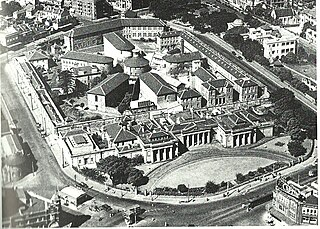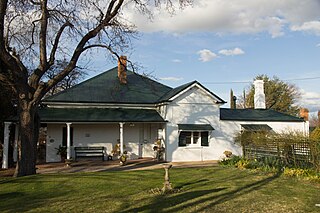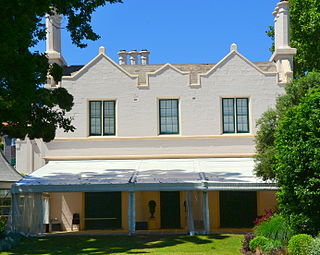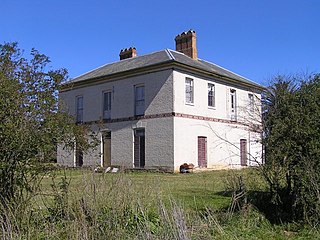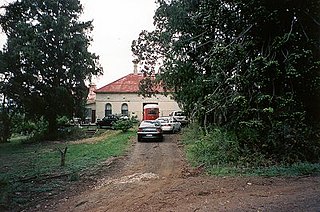James Atkinson ownership
Oldbury was established in 1822 by James Atkinson (1794-1834) on 3000 acres of land granted by Governor Macquarie. [1] From 1822 Atkinson became a beneficiary of convict assignments. [2]
James Atkinson was born in 1794 in Oldbury, Kent and was a farmer. He arrived in NSW in 1820 as a free settler on the " Saracen ". The land that would become Oldbury was granted by Macquarie, initially 800 acres, with conflicting sources as to whether it was in 1818 or 1821. [1]
In 1825 Atkinson returned to England and wrote "An Account of the State of Agriculture and Grazing in New South Wales". In his book Atkinson referred to emancipists and the poorer class in the Colony as Dungaree Settlers. The Sydney Gazette took Atkinson to task for being disrespectful to this class of people. [2] Maguire (2002) adds that Atkinson published several papers on agricultural matters between 1826 and 1829 - the best known of which is the one cited above, which was favourably reviewed by English author and polymath publisher, John Claudius Loudon. [1]
Returning to Australia in 1826 he married Charlotte Waring, the governess of Hannibal Macarthur's children, and applied to the Colonial Secretary for more land (1200 acres), which he received, and then proceeded to build Oldbury in 1828. He built the first windmill and evidently started milling flour on his property as well as dairy farming. He was a progressive man and encouraged activities such as ploughing matches. At Oldbury he created a model farm which won widespread admiration. [3] [1] Joseph Shelvey one of Atkinson's assigned convicts won a number of ploughing matches at Oldbury. [2]
In 1827 Atkinson was appointed a magistrate. He and Charles Throsby, another magistrate in the area, supervised the constables, lock-up keeper and clerk servicing their Court in Bong Bong.
Two of AtKinson's best friends were Alexander Berry and Edward Wollstonecraft who were magistrate landowners on the Shoalhaven River. Berry and Wollstonecraft had a large number of assigned convicts. From time to time they requested Atkinson to come down to the Shoalhaven to order punishments for their convicts. Magistrates could not order the punishment of their own convicts. [2]
James Atkinson died in 1834, "a gentleman of considerable literary attainments and as a practical agriculturist second to none in the colony" wrote the Sydney Gazette . [1]
A Robbery at Oldbury
About the 17 August 1829 a robbery took place at Oldbury when its storeroom was broken into. John Champley (a local store keeper) and his assigned servant John Yates with Joseph Shelvey were arrested for the crime. All three were subsequently sentenced to death at Campbelltown. The three were convicted primarily upon the evidence given by Patrick Brady also an assigned servant to James Atkinson. It was subsequently alleged that James Atkinson promised to give Brady a ticket of leave to give evidence at the trial.
Upon appeal by their barrister, Roger Therry, Champley, Yates and Shelvey were reprieved from the gallows. Governor Darling then sent Champley and Shelvey to Norfolk Island and Yates to Moreton Bay. About a year later two captured bushrangers from Jack Donohoe’s gang confessed to the robbery at Oldbury and Governor Bourke had Champley, Yates and Shelvey brought back to Sydney and pardoned. [2]
According to Sir Roger Therry one of the captured bushrangers, William Webber, before his execution, told James Atkinson where he had hidden the goods stolen in the Olbury robbery. He told Atkinson they were under a pile of stones and were still there. [4] If Atkinson did find the stolen goods it would appear he never informed the Government. [2]
Charlotte Atkinson
Surprisingly by 5 February 1835 Charlotte Atkinson declined the erection of a public monument in memory of her late husband that had been proposed by public subscription.
Then on 30 January 1836 Mrs Atkinson and her overseer at Olbury, George Bruce Barton left Oldbury for the purpose of an inspection of some of Mrs Atkinson’s sheep stations at Belanglo. During this time the two were bailed up by armed unidentified bushrangers. The bushrangers gave Barton a severe flogging with a stock whip and threatened to flog Mrs Atkinson although they did not do so. The bushrangers accused Mrs Atkinson of allowing her men to mistreat her assigned convicts. Strangely enough shortly after in March Charlotte married Barton.
An attempt was made to murder Barton on 30 June 1838 at Olbury. Charlotte and Barton were sitting at their parlour window when an unknown assailant fired a gun at Barton. The ball passed through Barton's clothing but did not kill him. Iron gang convicts were suspected of the crime. [2]
Charlotte wrote the first published children's book in Australia: 'A Mother's offering to her children'. [1]
Louisa Atkinson
The youngest daughter of James and Charlotte Caroline Louisa Waring Atkinson (1834-1872) was born just 8 weeks before James died. Always delicate, she spent her youth writing and collecting and drawing animals and botanical specimens near her homes - first at Oldbury and later at "Kurrajong" (Fernhurst) in the Blue Mountains and on the South Coast of NSW. A keen horse rider, she would set out on horseback to gain access to deep gullies and high ridges. [1]
At 23 she published her first novel, Gertrude the Immigrant: a Tale of Colonial Life which was to be followed by five more (some were serialised in the Sydney Mail(1861–72) and regular columns in the Sydney News (1853–55), Sydney Morning Herald and The Sydney Mail (1860–71), where her columns entitled 'A Voice from the Country' were often accompanied by her own sketches. It was as a botanist however that her contributions were most valuable. [1]
She corresponded with the leading botanists of the day, including (making collections of botanical specimens for) The Rev. William Woolls (of Parramatta) and Baron Ferdinand von Mueller (Govt. Botanist of Victoria, Director of the Royal Botanic Gardens, Melbourne), who named a species of mistletoe, Atkinsonia ligustrina after her. Xanthosia atkinsoniana, Erechtites atkinsoniae (now Senecio bipinnatisectus) and the heath Epacris calvertiana also carry her names. [5] [1]
Atkinson was as well as a botanist, a naturalist, artist and author of many books on native flora and fauna. [3] [1]
Louisa Atkinson, her sisters and brother spent their earliest years in this house, garden, farm and surrounds. She became one of Australia's earliest botanical explorers. The first Australian native-born woman novelist (as E. Morris Miller's "Australian Literature" attests), Louisa was one of the earliest women journalists. She was also an artist of technical ability and great verve of expression. [6] [1]
In 1869 Louisa married explorer and naturalist James Calvert (1825–84) who had accompanied Ludwig Leichhardt on his 1844-45 expedition. Always interested in horticulture, he won a medal at the 1862 International Exhibition in London for his entry on the possible commercial cultivation of native flax. [7] [1]
Her regular popular natural history columns in the "Sydney Morning Herald" were re-published by Victor Crittenden in two volumes through his Mulini Press in 1978 as "A Voice from the Country" (the pseudonym Atkinson used for the articles - it was not common for authors to sign their work in those days) and as "Excursions from Berrima and a Trip to Manaro and Molonglo in the 1870s", which was articles about her travels and botanical searches on the Southern Tablelands of NSW. [6] [1]
Louisa's first novels originally appeared as serials in The Sydney Mail and only her first two novels, "Gertrude the Emigrant" and "Cowanda, the Veteran's Grant" were published as books in her lifetime. "Myra", "The Debatable Ground" and 'Tom Hellicar's Children' were re-published by Mulini Press. 'Tom Hellicar's Children' paints a picture of childhood in the Berrima district and recalled her own memories of life at Oldbury. The novel recounts the cruel treatment of three children by their guardian uncle. They are dispossessed of their idealistic home as Louisa was when her father died and the whole family fled from their brutal alcoholic stepfather. [6] [1]
Elizabeth Lawson's book "The Distant Sound of Native Voices" focused on Atkinson's writings on Aboriginals - some of Louisa's earliest published illustrations were of Aboriginal remains near Oldbury. Lawson's 1995 book "The Natural Art of Louisa Atkinson" Louisa's writings and artwork. Louisa was trained in art by her mother Charlotte, who had in turn received lessons from John Glover. Louisa prepared a book of her own artwork for publication, which has never been traced. It was to include the botanical and flower paintings, birds and animals of NSW. Ferdinand von Muller, with whom she had corresponded on botany over the years, had sent the book to Germany to have the illustrations engraved by experts. The book was never published as she died while it was in preparation and it disappeared. It may have been burnt in the great bonfires at Oldbury when the house was sold some years after her death. She died tragically in 1872. [8] She died tragically just 18 days after giving birth to her only child, a daughter, Louise Snowden Calvert. [9] [1]
The avenue of English (European) elms was planted by James Atkinson, his idea being to continue them to Mereworth, as a link to his brother John's property, Mereworth. John's property, Mereworth is situated on the western side of the (present) Hume Highway from Oldbury and the two were connected by an unsealed road (now bisected by the realigned Hume Highway). [1]
Post-1834
Following James Atkinson's death in 1834, his executors decided to lease the property and sell the stock, providing his widow an income to allow her to live in Sydney. His widow, son (also James Atkinson) and daughter Louisa later returned to the property. Louisa's marriage to Calvert was held in the sitting room at Oldbury Farm in 1870. James Atkinson junior and then Louisa Atkinson inherited the property in turn. [10]
The roof was altered in form and materials in the 1920s. [1]
It was owned by Montague Nicholson in the 1940s, who referred to the farm as "Swanton". [10]
The house was reportedly untenanted for long periods until its restoration c. 1960s by J. McDonald. [11] The house had a corrugated iron in the 1960s. [1]
In 1983, the house underwent a total restoration by Clive Lucas & Partners, including putting the roof back to its original 1920s form, reshingling the roof, and reconstructing the portico and front steps, based on measured drawings by William Hardy Wilson in the 1910s-20s. [1]
In the 1970s, it was owned by prominent advertising agency figure Elizabeth Dangar, who was married there in 1979. [12]
A program in recent years of rejuvenation, replanting and revival of laid hawthorn hedges on the farm has been implemented. Hedge laying is an old European practice which produces stock-proof farm hedges. A similar program of rejuvenation of the garden has been underway in recent years. [3] [1]


